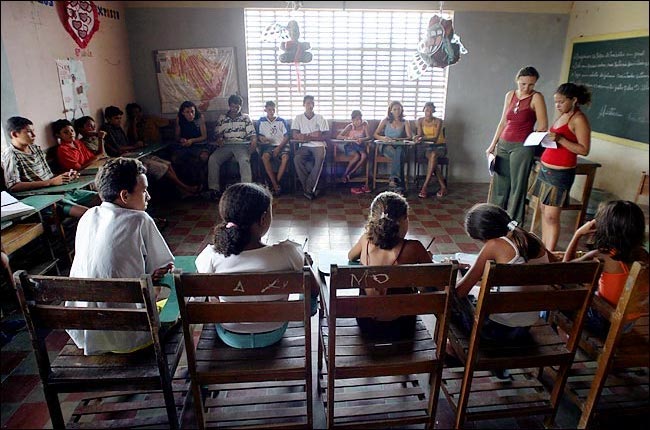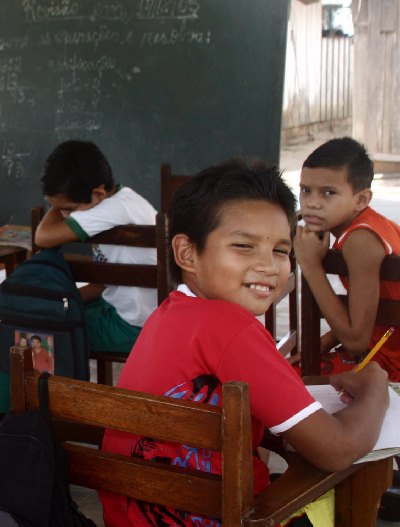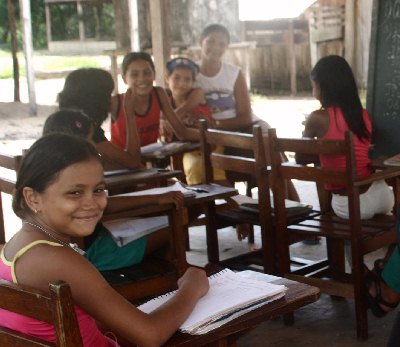|
|
|||||||||||||||||||||||||||||||
|
Disaster Capitalism in Brazil's Education System
The Commodification of Education
By Joycelyn Hackshaw - 2008. Public education systems all over the world are facing threats of privatization. As cut in government funding prevail, private organizations are taking control of public funded education system and transforming them into privately funded, for profit organizations. These schools operate like businesses, where education has become a commodity and principles act as heads of corporations. Brazil is no exception, in Brazil the education system has always been segmented involving both public and privately run institutions. Changing government policies coupled with neoliberal policies introduced by the World Bank and the International Monetary Fund, following the debt crisis transformed the education system, increasing the number of private institutions. The focus of this essay is to detail the history of Brazil’s education system and the way it has been affected by changing policies, which contributes to widening disparities between the rich and the poor. In her book The Shock Doctrine, Naomi Klein documents the way neoliberal ideas have transformed nation states, introducing them to competition on in a global market. Friedman’s neoliberal belief in the rule of the market and the changing role of the state, where their responsibility for providing universal social services have been removed have dominated the economics of many countries. Some countries have adopted these policies democratically while others have had neoliberal ideal push onto their economies. Klein discusses this practice, supported by Friedman, where privatization of states assets and resources occur immediately following a crisis. This practice of privatization of states resources, when citizen are disorganised and recovering from a crisis or disaster is term “disaster capitalism” by Klein and have occurred in several different places including, New Orleans following hurricane Katrina where the public education system was replaced by a privately run charter system (Klein 6) and in Sri Lanka where coastlines devastated by the tsunami in 2004 were handed over to foreign investors and international lenders to build resorts. In Brazil where social services were affected by the debt crisis, the ensuing World Bank policies promoted neoliberal ideas and a drive towards decentralization and privatization in the market. Here the function and responsibility for school are transferred to municipalities, states and the school. Derqui links decentralization to “neo-liberal restricting of the states, to pressure form globalization processes and forces and to various internal demands for improving quality and efficiency in the delivery of education.” (Derqui 562) Decentralization policies allow for government to move away from the burden of covering the cost of education and to take on the role of conflict managers by diffusing the sources of conflict, redistribute political power to school and local organization as a way of increasing participation of teachers and local community in decision making processes. (Derqui 563) Decentralization is another form of privatization, where an arena is created for competition and where a schools function is determined by its ability to uses the resources it has and to provide students with an education encourage participation in society. In these arenas the gap between the rich and the poor can be dramatically increase as access to education is limited by the resources and access to schools. In Brazil’s education system decentralization policies have been constructed as a way of improving quality of education, through the transfer to schools of resource management in order to gain efficiency and a system of participation mechanism, where principals are democratically elected. In many of these schools fragmentation of the education system have occurred where schools are abandoned to their own fate and adopt a management model derived from business enterprises. (Derqui 572) The education system continues to function under neoliberal ideas and policies.
Prior to the 1930 Brazil had no national education system, education was provided by state, local and private agencies which operates individually. (Derqui 564) The “revolution of 1930” transformed education into a priority for the government and placed the responsibility for it administration in to the hands of the government. The Vargas government sought to create centralization in the bureaucracy that governed education. They developed the pioneer proposal which deal with “the way education should take place, through the active participation of the students in the learning process, and on the way Brazilian education should be organized, through the establishment of public universities, free, universal mandatory and basic education, and the education of teachers in university-level institutions.” (Schwartzman 14) The government of this period sought to control education without taking responsibility for management, administration and decision making in school which remain in the control of the state, municipal and private authorities. The education practices of the Vargas regime shaped Brazil’s education system for many years. Following the Second World War Brazil entered a period of expansion where economic growth and urbanization took place. This growth encouraged by Presidents João Goulart’s policies of land redistribution, increasing salaries and forcing foreign multinational to reinvest profits into Brazil (Klein 73) helped to improve the economy and improve the livelihood of many Brazilian reducing the gap between the rich and the poor. This expansion also created demand for education, the government responded by creating a network of universities and expanding the elementary and secondary system. Private education institutions also increased their capacity by catering to elites in selective schools and opening cheap alternatives for middle class, students who failed the university entrance exams and fro those who wanted to combine work and study. (Schwartzman 16) A country with a national debt of $3 billion in 1964 by 1985 Brazil had accumulated a national debt of $103 billion and found itself in the debt crisis that swept Latin America in the 1980’s (Klein 187). This crisis created the condition necessary for “disaster capitalism” to occur. Through International Monetary Fund and World Bank structural adjustment policies government are expected to take a neoliberal approach to governance and development in their countries. They are expected to reduce national spending on social services and open their market to international and private investments and to allow the resources of the country to be privatized. During this period all social services as well as education experienced several changes. The military government that seized power passed laws that not only reversed Goulart’s pro-poor programs but cracked Brazil open to foreign investment. (Klein 77) They encourage financial decentralization of the education system where they reduce funding and spending in education. By the 1980 municipal schools were viewed as more cost effective, alternative to delivering education, even though they were weak in their administrative and financial capacities.” (Derqui 565) Education policies through the 80’s and 90’s were affected by structural adjustment programs that were grounded in neoliberal ideas. These policies helped to create a situation where decentralization policies in order to cut “fiscal deficits and increase the efficiency and quality of education system” (Derqui 567) were constructed as the way to improve the education system while ignoring the socio-economic status of many Brazilians and other problems that prevented them from being able to attend school. These policies transferred financial responsibilities to local government and communities where the economic and socio-economic status of the area determined the quality of education that would be received by students.
 During the 90’s Brazils economy was further restructures under neoliberal ideas to facilitate its entrance on the global market. Restructuring occurred in all social sectors including education, where modernization increased cost resulting in greater social segmentation. Between 1992 and 2002 the government introduced policies to reduce regional differences and to set the stage for state and municipal expenditure on fundamental education. The National Fund for Basic Education (FUNDEF) was developed to insure that funding air marked for education was actually spent on education. Other policies developed during this time includes new curricular guidelines for basic and secondary education, programs that provided schools with managerial, pedagogic and resources to improve performance and the introduction of a program that paid the poorest of families to send and keep their children in schools. (Schwartzman 26-27) These programs led to an increase enrolment at all education level, more resources for teacher training and salaries and more equipment and resources for schools, leading the government to announce that every child in Brazil had a place and was enrolled in fundamental education. (Schwartzman 27) This produced the view that the education system in Brazil was working and the ever child had equal access to the same education. These policies however ignored the disparities that exist across the different regions in Brazil and it consequences on education. Brazil’s education system has been plagued by problems in teacher education. During the Vargas regime the ideology was adopted that society should be organized into a “well regulated and hierarchical corporation where each profession had its own education prerequisites to be provided or certified by the state and supervised by the state” (Schwartzman 20) This ideological belief created a system where high prestige was given to education credentials, those who had no or little credential were placed at the bottom of the hierarchical system. In this structure teaching fell to bottom since many teachers did not have credentials and the level of credentials varied depending on the area of the education system they were involved in and what they teach in the school. (Schwartzman 22) Brazil has never had an institution that was full devoted to training teacher for work in the class room, education for teacher has been provided by the public and private system where “traditional ‘teaching’ social science, history and geography” (Schwartzman 21) courses “recruited students coming from poorer background who have a difficulty getting into more the competitive fields, or older teachers returning to evening courses to get their newly require academic credentials.” (Schwartzman 22) Teaching in Brazil became secluded as a result of this hierarchical structure and the resulting segmentation between various levels of teachers as a result of their credentials. Schwartzman outline the way that new teacher trained in traditional social sciences are affected, they become highly organized and politically motivated, despite being devoid of adequate competencies or knowledge in their subject area. (Schwartzman 22) This system helps to create teachers who see society as unfair, where people as being exploited and governments as not interested about teachers or education, they also believe that the way to change societies is through transformation or revolution. (Schwartzman 22) These ideals are reflected in the Education’s Iron Cage where resistance to neoliberal ideas and policies are seen as a way of reducing inequalities in education, making it accessible to poorest members of society, improving the quality of teaching thereby reducing the gap created by socio economic difference in countries like Brazil.
Despite having one of the largest market-based economies in the world Brazils education have been affected by neoliberal ideas and the disaster ethic of Milton Friedman. Due to structural adjustment policies, the social and economic gap has widened. The education system was significantly restructured during the debt crisis and responsibility of providing education in Brazil was placed in the hands of private institutions. The privatization agenda in Brazil have created a two tired system of education a privately funded system that provide education to the elites and those who can afford it and a public funded system where the system is under strain as financial cost increase and institutional structure breaks down. “Public schools in poor regions, municipalities and neighbourhoods tend to be of worse quality, and achievement depends heavily on the family’s economic, social and cultural background. Middle and upper class families send their children to private basic and secondary schools,” (Schwartzman 6) these schools are of better quality and prepare students for the most prestigious and free higher education institutions. Students from poor families if they do enter higher education often enter the private system where they have to pay for an education that is of low prestige and quality or the public system where they enter the less prestigious course. There is a strong relation between good school and the socio-economic conditions of the students. Student with parent who have the ability to pay for education usually do so, while poor students are left in a system that is in need of resources. The removal of education form the government have resulted in a system that maintain a hierarchical system, where neoliberal market rule ideas are maintained and where the gap between the rich and the poor is maintain. The education system of Brazil have been affected by “disaster capitalism” where it was transformed and privatized during a period when the majority of society were worried about the consequences of the debt crisis on there lives. As the effect of the neoliberal approach to education come to light, community organizations, educator and students alike have began to come together to create a change in the education system, they want a system where everyone have equal access to education and where teachers have the resources and support to provide student with and education that is of some value for them as well as the society.
ReferencesA multi-union research team from Argentina, Brazil,Chile And Urugay. "Education Reform in Latin Americas Southern Cone: Points of resistance." Anderson, Bill. Education Iron Cage and its Dismantling In The New Global Order. Toronto : The canadian Center for policy alternative, 2006. 35-57. Derqui, Jorge M Gorostiaga. "Education decentralization policies in Argentina and Brazil: exploring new trends." Journal of Education policy (2001 ): 561-583. Klein, Naomi. The Shock Doctrine: The Rise of Diaster Capitalism. Toronto : Alfred A. Knopf , 2007. Schwartzman, Simon. "the Challenges of Education in Brazil." (2003): 1-44.
|
|
||||||||||||||||||||||||||||||
|
Website Design + SEO by designSEO.ca ~ Owned + Edited by Suzanne MacNevin | |||||||||||||||||||||||||||||||



